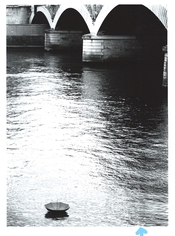I'd like to know how you'd deal with the following problem in order to properly print a photo you really love.
When developing the film of the attached picture, I repeated a mistake that I've made before (and was coincidentally one of my first posts in apug years ago ): I poured the developer too fast, an air pocket formed at the top of the tank and the negatives feature a beautiful light band of underdeveloped film.
): I poured the developer too fast, an air pocket formed at the top of the tank and the negatives feature a beautiful light band of underdeveloped film.
In order to print this negative, I dodged the bejesus out of that band marked with a blue arrow (2/3 of the total exposure time) and got it to be virtually invisible on the wet print. Imagine my surprise when I opened the blotter book days later and found that the area had darkened considerably. So, while I wait for the darkroom to open back up: how would you deal with this? Is there an alternative to dodging that I should explore? If it's any help, I'm just using one filter on this one, no split-grade filtering.
Thank you!
When developing the film of the attached picture, I repeated a mistake that I've made before (and was coincidentally one of my first posts in apug years ago
 ): I poured the developer too fast, an air pocket formed at the top of the tank and the negatives feature a beautiful light band of underdeveloped film.
): I poured the developer too fast, an air pocket formed at the top of the tank and the negatives feature a beautiful light band of underdeveloped film.In order to print this negative, I dodged the bejesus out of that band marked with a blue arrow (2/3 of the total exposure time) and got it to be virtually invisible on the wet print. Imagine my surprise when I opened the blotter book days later and found that the area had darkened considerably. So, while I wait for the darkroom to open back up: how would you deal with this? Is there an alternative to dodging that I should explore? If it's any help, I'm just using one filter on this one, no split-grade filtering.
Thank you!









